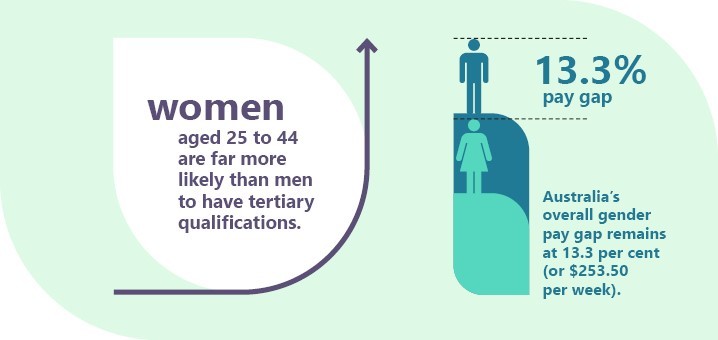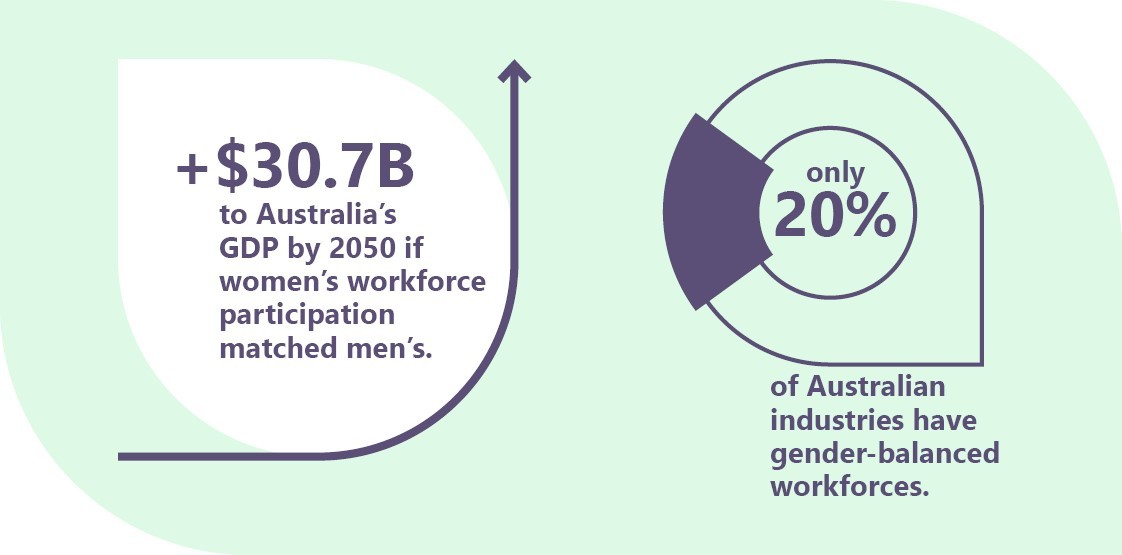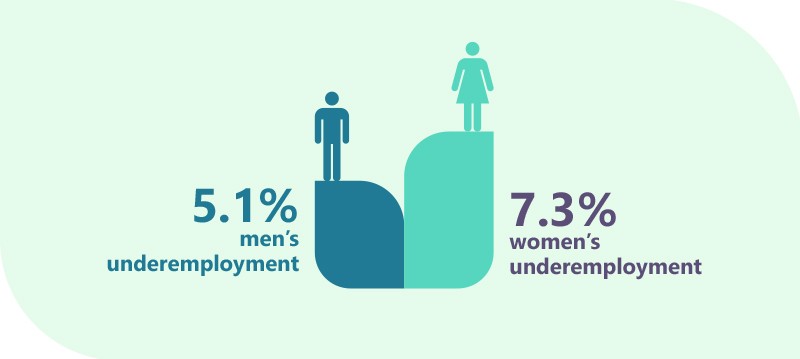This section explores some of the factors that contribute to women’s economic inequality. Over their lifetimes, women are more likely to earn less than men, are less likely to advance as far in their careers as men, and tend to accumulate less superannuation than men. On average, women tend to retire earlier than men. The cumulative effect of these factors can have negative impacts later in life, particularly for women who go through a relationship breakdown or divorce.
Single mothers can face particularly acute challenges in relation to workforce participation and financial security that can have significant impacts for their lifetime earnings and retirement incomes.[4]
Women migrants tend to have weaker economic outcomes than migrants who are men, and the gender gap in labour force participation is also higher among migrants when compared with the Australian general population.[5]
Gender pay gap
Gender pay gaps are an internationally established measure of women’s position in the economy in comparison to men. Australia’s national gender pay gap measures the difference between the average weekly ordinary time earnings (i.e. base salaries) of women and men working full-time. The gender pay gap is sometimes misunderstood to be two people being paid differently for the same work or work of the same value. However, this is a matter of equal pay, which is protected by legislation.

Australian women are among the most highly educated in the world. Girls are more likely than boys to complete Year 12 education,[6] and women aged 25 to 44 are far more likely than men to have tertiary qualifications. However, this has not translated into better economic outcomes for women – Australia’s overall gender pay gap remains at 13.3 per cent (or $253.50 per week), and graduate gender pay gaps favour men in most fields of study.[7]
Almost 40 per cent of workers under 40 do not agree women and men are treated equally in their workplace, have the same chance for promotion, are listened to equally or are paid the same for work in similar roles. Women are more likely to identify gender inequality than men, and there has been little change in gendered perceptions of equality at work between 2017–2022.[8]
Workforce participation and occupational segregation

The underrepresentation of women in the workforce has a great impact on the Australian economy – if women’s participation matched men’s, Australia’s GDP would increase by $30.7 billion, or 8.7 per cent to $353 billion by 2050 and create an additional 1 million full-time equivalent workers with post-school qualifications.[9] While labour force participation is near record highs, it is still lower for women than men. This is due to a combination of factors, including the gender segregated nature of the Australian workforce, the undervaluation of female dominated work, and women taking significant time of out the workforce for child care - underrepresentation of women can have a significant impact on the economy.
Australia has some of the most gender-segregated occupations, as well as some of the most gendered division of labour among Organisation of Economic Development and Cooperation (OECD) member countries. Less than half of Australian industries have gender-balanced workforces (at least 40 per cent women and 40 per cent men).
Gendered occupations have persisted over the past 20 years, with the proportion of women in traditionally female-dominated industries increasing.[10] Women continue to be concentrated in Health Care and Social Assistance as well as Education and Training. Men are more likely to be found in Mining, Electricity, Gas, Water and Waste Services, Construction, and Manufacturing.[11]

Women’s unemployment is at 3.5 per cent, one of the lowest levels on record, and the participation rate is 62.1 per cent, among the highest on record. However, the women’s underemployment rate (7.3 per cent) remains significantly higher than men’s (5.1 per cent). In Australia, working women are also more than twice as likely to be in part-time work as working men and are more likely to be in casual employment. Part-time and casual work provides flexibility to manage unpaid caring roles. However, casual jobs can also be less secure and lower paid with less opportunity for career progression.
Further information and key gender statistics can be found in the 2022 Jobs and Skills Summit – Issues Paper on the Treasury website.
Workplace sexual harassment
Workplace sexual harassment is driven by power disparities, particularly gender inequality. Other forms of discrimination can also drive sexual harassment. Almost 2 in every 5 women experienced sexual harassment at work between 2013 and 2018, while 1 in 4 men experienced harassment. First Nations people, people with disability and LGBTIQ+ people are more likely to have experienced sexual harassment. Most sexual harassment in the workplace is not formally reported.[12]
Male-dominated workplaces have a higher prevalence of sexual harassment. This is due to a range of factors, including an unequal gender ratio, senior leadership that is predominantly male, and women performing roles that are considered ‘atypical’ for women.[13]
It is estimated that workplace sexual harassment cost the Australian economy $2.6 billion in lost productivity.[14] International research has also indicated that the financial impacts of workplace sexual harassment are felt more acutely by women, as they are more likely than men to make lateral moves or take pay cuts in response to experiences of harassment.
Prompt
What are the underlying challenges for women’s economic equality that the strategy could address?
[4] Women's Budget Statement October 2022-23 p. 33
[5] Women's Budget Statement October 2022-23 p. 29
[6] For further information: ACARA (Australian Curriculum, Assessment and Reporting Authority) (n.d.) ‘2021 Apparent retention rates from Year 10 to Year 12’, Key Performance Measures for Schooling in Australia, accessed on 20 September 2022.
[7] For further information: WGEA (n.d.) Gender pay gap data, accessed on 7 March 2023; Social Research Centre (2021) 2021 Graduate outcomes survey, Quality Indicators of Learning and Teaching, October 2021, p 7-8.
[8] University of Sydney Gender dynamics in the post pandemic future of work March 2023.
[9] Equity Economics (2021) Back of the pack – How Australia’s parenting policies are failing women and our economy, December 2021, p 9 and CEW (Chief Executive Women) (2002) Addressing Australia's critical skill shortages: Unlocking women's economic participation, Sydney.
[10] Deloitte Access Economics (2022) Breaking the norms: Unleashing Australia’s economic potential, Report prepared in partnership with Australians Investing in Women, November 2022.
[11] WGEA (2022) Australia’s gender equality scorecard 2020–21, Sydney, February 2022.
[12] Women's Budget Statement October 2022-23 p.54
[13] Women's Budget Statement October 2022-23 p.54
[14] Deloitte Access Economics, The economic costs of sexual harassment in the workplace, March 2020
